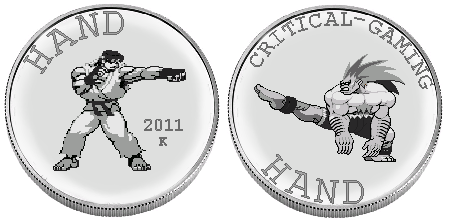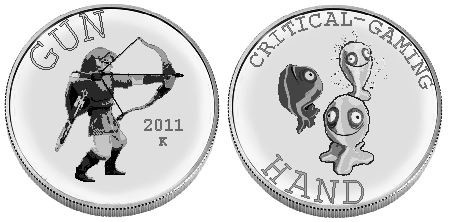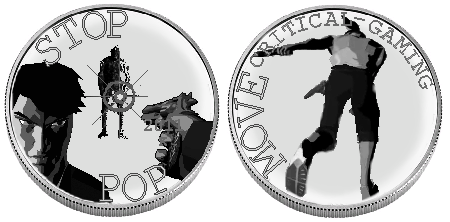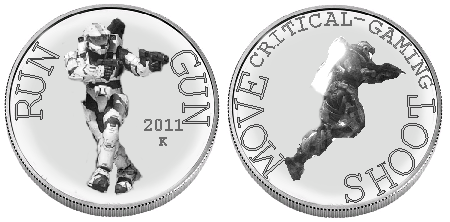Simultaneous actions. You may not know exactly what I mean here, but I'm sure you will fall on one side or the other of this divisive issue. So allow me to delay explaining it for just a bit longer in order to make a point (and present my case).
In part 1 of this article series, I carefully explained what makes various gameplay choices interesting. For a quick recap, when you don't have an obvious and/or dominant strategy, various choices can reach the goal in different yet "equal" ways. And in a combat system built around interesting choices, one interesting choice tends to roll into more interesting choices as the pendulum of counters swings back and forth between sides (interplay). If you take all the positive elements of your choices and remove all the negative drawbacks, you'd have a much simpler game that's much less interesting. This idea goes hand in hand with tuning player strength, which is an area of design backed by flow zone theory.
So do you agree with what I've explained? If so, then you're on my side. You're against being able to move and shoot simultaneously! That's right. First person shooters, SHMUPs, top down shooters, twin stick shooters, 3rd person shooters are all flawed in their design! Of course, I'm exaggerating here. The real issue is not so simple. To explain, I'll start with a quote from Miyamoto.
Miyamoto: Let's say, for example, that there's one action in the game that the player can perform easily. Then let's add another simple action. These actions may be simple in themselves, but when the player is required to do them both at the same time, it becomes a whole lot more tricky. [Iwata Asks]
Miyamoto has excellently expressed the unique challenge/experience that comes from trying to do two actions at the same time. I should state that there's nothing inherently wrong with simultaneous actions. To understand how being able to do two actions simultaneously can make a gameplay system less clean, you must understand how mechanics design shapes the emergent whole.
I'm perfectly aware that games featuring any kind of hand-to-hand or shooting combat do not make up the entierty of gaming experiences. But for the purposes of illustration, the issue of simultaneous actions is most clear when considering avatar movement and attacking actions in 2D/3D space. The following article examines the kinds of gameplay/interplay that can emerge out of close, long, and mixed ranged combat mechanics.
From Hand-to-Hand...

No matter how the coin drops, it's a hand-to-hand fight.
Let's start with hand-to-hand (close range melee) combat. If two player-controlled-characters engage in hand-to-hand combat, both will simultaneously try to hit the the other while trying to avoid incoming attacks. Fighting games specialize and excel in this kind of gameplay. The unique shapes that bodies and attacks sweep out through space (whether 2D or 3D) create unique holes that keen players can take advantage of. But if you look very closely at traditional fighter design, players cannot generally move and attack at the same time. You can either move or attack. Once the attack starts you cannot change the position of your character or the motion of the attack until it is finished. An exception includes moves like Super Street Fighter 4's Blanka's EX rainbow ball.
To compensate for this stand-and-strike fighter design, movement is built into the some attacks. In the Naturo fighters, basic attacks step characters forward. In Street Fighter, there are all kinds of special moves that have unique motions like the hurricane kick. These are all great additions, but some games go beyond this.
For more next-gen fighters moving and attacking can be done simultaneously with independent control. The Super Smash Brothers series does this especially well with air control. Using the analog stick players can adjust the horizontal trajectory of their characters in the air even while attacking. Wii Sports Boxing and Super Monkey Ball 2: Monkey Fight offer similar simultaneous moving and attacking options.
Ultimately, in hand-to-hand combat systems all players must draw close to each other to land attacks. This greatly reduces the chance of emergent issues for a stand-and-strike or a simultaneous moving and attacking type games. Drop a gun into the scenario and things change.
To Gun-to-Hand...

Which side will you choose?
In any Zelda game, Link gains a large advantage over many enemies when he uses his boomerang, arrows, or beam sword. Sure, ammo limits the arrows and the beam sword can only be used in full health. But while you have these advantages, enemies that need to close in are at a serious disadvantage. In Zelda because players have to move through the environment and killing most enemies is optional, running away to shoot from a distance isn't a dominant strategy.
For other gun-to-hand games that have a greater focus on combat, movement mechanics and gunplay (interplay with guns) are important to consider. Obviously, this is an issue of balance. Both the gun side and the melee side need to be able to influence and counter each other at long and close range. The clearest way to create such an interplay system is with...
To Stop-and-Pop...

It's one way or the other. Can't have both.
Keeping movement and shooting mechanics independent creates clear interplay (natural counters) and develops combat by cutting to the chase. This is why I designed Neo*PRG so that players can't move and shoot simultaneously. Designing the whole control scheme around the mouse keeps players from missing the option, I think. Instead of continually running away (obvious strategy #1) and continually shooting in one's wake (obvious strategy #2), when you stop to shoot you clearly create a simple opening for enemies to close in the gap and surround you. Because enemies are very dangerous in groups you're forced to think ahead and engage with the combat system instead of dragging things out. Seeing a threat coming when you can't just move out of the way creates more tension with organic timers.
Here's a short list of games with stop-and-pop mechanics.
- Resident Evil series including 4 & 5. I'm a fan of old school and new school RE combat. A slow moving zombie is more tense than a fast running zombie. But that's just how tension goes. In the upcoming 3DS games you can move-and-shoot (see video) We'll see how that goes.
- Metroid: Other M. Releasing the charge shot limits movement. Going into first person is the only way to look around freely. (see video) Also, missiles and super missiles can only be fired in first person. This design is similar in Metroid Prime 1 & 2 (GameCube) in that players can only look around freely when they lock their movement in place.
- Killer 7 (video here). Stop, scan, aim at the golden weakspot, and shoot. "Don't make me say it again..."
- Some Legend of Zelda games. Zelda NES. Link's Awakening. Phantom Hourglass. Spirit Tracks. (see video) Most combat mechanics stop or limited Link's movement.
- Some StarCraft units. The Seige Tank is the best example. However, there are many units that cannot move and shoot especially while retreating. This is where micro comes into play. (see video) With some finesse, players can briefly stop just to shoot and then quickly resume moving. The Phoenix can move and shoot as well as the Carrier, Void Rays, and Mutalisk.
- Ninja Gaiden: Black (Xbox only). (video here) In this version you can't shoot arrows without going into first person. Needless to say, in first person you cannot move.
- Advance Wars. In this strategy game you can only move then attack. After you attack with a unit, it goes into an idle state. With this design attacking commits you into a position. And when you turn passes over, the give and take interplay is clear. Such is the nature of turn based games.
- Mario Strikers Charged. Charging a shot (non chip) or a pass forces the ball carrier to stand still.
When you can move and shoot simultaneously, the players are able...
To Run-and-Gun...

As much as I love the Geometry Wars series (which I've played every version of), it took some of the modes in the Geometry Wars Galaxies (Wii/DS) and in Geometry Wars 2 (360) to refine the gameplay to my liking. The static and stale strategy of running away, shooting backwards, and moving along the sides of the stage is too powerful in the original Geometry Wars (GW). Only special enemies like the black holes, red enemies, and snakes temporarily force me out of this strategy. Furthermore, with an instantaneous BOMB mechanic, I always have a get out of trouble free option. The longer the games last, the less interested I become. How long can you watch this video before getting tired of the refined strategy. Or this one of Super Crate Box (another game I like).
To reduce the static space created by moving-and-shooting in GW, coin like enemy drops in Galaxies and in GW2 encourage players to adapt their movement routes on the fly. Furthermore, modes like wave, pacifism, and king practically eliminate the previous dominant strategy and replace it with new more balanced and engaging ones.
Notice in the stop-and-pop list above most of the enemies in these games don't shoot back. When both sides have firepower the situation changes. If you try to run in an FPS, you can be shot in the process. The conditions are fair and potentially engaging for all players. In other words, the same ability you have to hit targets from a distance is available to your opponents. So in general, until the line of sight is broken, you're in danger in a shootout. If a shooter isn't well-tuned the dreaded FPShuffle can emerge in player behavior. But this kind of clutter is a behavioral-fictional issue, which I'll address later in this series.
For the record I have no problem with run-and-gun shooter gameplay in general. The main point of this article is to illustrate emergent issues that create static space or dominant strategies can occur in games more easily when players can simultaneously use their core mechanics because they can potentially use both to maximum effectiveness. This can be fine in games of equal conditions for all players, yet troublesome for games of guns-and-hands. If you want to design a game where players engage in combat without distractions, perhaps it's best not to give them the ability of full simultaneity without having one action limit the other. It doesn't have to be as drastic as stop-and-pop.
In part 3 we'll look at feedback and the subtle design touches that help players understand what's going on.